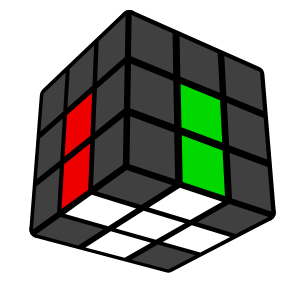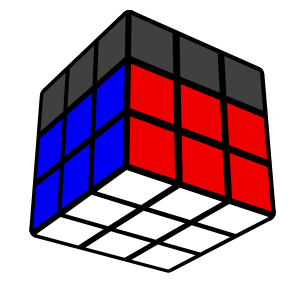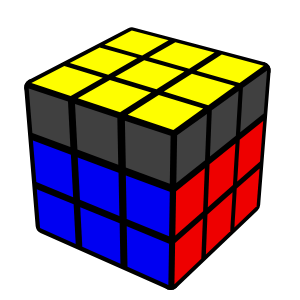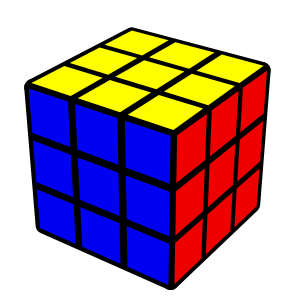An overview of speedcubing (+Awesome learning resources)
When I first learned to solve the Rubik's Cube back in 2014, it took me less than 2 hours to learn the beginner's solution. But I quickly got bored. I was pulled into the deep rabbithole of speedcubing—an exercise where people try to solve the cube in the fastest time possible1.
This guide will give you a thorough introduction to what speedcubing is and a collection of the best resources online that you can use to achieve a sub 30 result in the fastest time possible. Even if you are already familiar with speedsolving techniques, read on, as you might discover something you didn't already know.
The method I use is called CFOP, popularized by Czech mathematician Jessica Fridrich in 1997. This is the most popular speedsolving method used by cubers today, among others like ZZ, Roux and Petrus.
Introduction to CFOP
There are 4 steps in this method:
- Cross
- F2L (First 2 Layers)
- OLL (Orientation of Last Layer)
- PLL (Permutation of Last Layer)
Cross

The first step involves making a cross on one side by solving all edges of a given face and aligning the edges with the second-layer centers. Most speedcubers usually solve the cross on the bottom to avoid cube rotations and to get an overall better view of the important pieces needed for the next step. This is called 'Lookahead'. In speedcubing competitions, cubers take their 15 second inspection time to plan required moves for a cross (in many cases, the first F2L pair as well!) to save time. In all cases, the cross can be done in less than 8 moves. Most speedcubers are color-neutral, meaning they can start with any colored face without slowing down.
F2L

In F2L, corner and edge pieces are paired up using the free top layer and later moved to their correct location. The four slots between the cross pieces are filled in, one slot at a time, by inserting a corner and its corresponding edge simultaneously. Most of the 42 distinct cases have reasonable intuitive solutions. So, algorithms are not required for this step unless you aim to achieve sub 25 or better results. The completion of this step leaves one with just the last layer, typically placed on top.
OLL

This stage involves manipulating the top layer so that all the pieces therein have the same color on top, at the expense of incorrect colors on other sides. This stage involves a total of 57 distinct cases. Multiple algorithms (in some cases, 10+) can be used to solve a single OLL case. You just need to remember the easiest one.
A simpler version, called "2-look" OLL orients edges first and corners afterwards. It uses 10 algorithms, 3 for edge orientation and 7 for corner orientation.
PLL

The final stage involves moving the pieces of the top layer while preserving their orientation. There is a total of 21 cases for this stage.
Just like 2-look OLL, "2-look" PLL solves the corners first and edges separately. It uses 6 algorithms, 2 for corner permutation and 4 for edge permutation.
Recommended order to learn CFOP
- Be comfortable with solving the Cross and F2L intuitively.
- Learn 4 look last layer (2 look OLL + 2 look PLL).
- Learn full set of PLL algorithms.
- Learn the remaining OLL algorithms.
- Learn advanced algorithm sets and techniques while working on your Cross and F2L efficiency (see below).
Terminologies
There are some very common moves and terms in speedcubing that you should know.
-
Triggers
These are 3 or 4 move sequences that commonly appear in multiple algorithms which makes them easier to memorise.
- Sexy:
R U R' U' - Sledgehammer:
R' F R F' - HedgeSlammer/Reverse Sledgehammer:
F R' F' R - Sune/Anti-chair:
R U R' U R U2 R'and variants. - Antisune/Chair:
R U2 R' U' R U' R'
For example, in T OLLs, instead of memorising the full alg like
F (R U R' U') F', you could remember it instead likeF Sexy F'or in case of(R U R' U') (R' F R F'), asSexy Sledgehammer. - Sexy:
-
- TPS - Turns Per Second
- AUF - Adjust U Face
Personal recommendations
-
Learn to use the inspection time in practice solves.
-
Learn fingertricks as early as possible.
-
Attempt to complete the cross in less than 8 moves. Plan out the entire cross during inspection.
Look into X-Cross (Extended Cross). This means solving the cross plus 1 F2L pair simultaneously.
-
Learn F2L intuitively. With enough practice, your muscle memory will make learning the algorithms obsolete.
-
Learn 2-look OLL first along with other easier OLL cases.
- Print out this set of OLL algs from Feliks Zemdegs' CubeSkills site.
- 2-look OLL - JPerm.
-
Learn 2-look PLL first. It is recommended to learn the entire PLL as soon as possible since there are only 21 algs on the set.
- Print out this set of PLL algs from CubeSkills.
- 2-look PLL - JPerm.
-
Practice color neutrality right away. In beginning stages, OLL and PLL may seem to be overwhelming but as you learn the algorithms, that will get easier. But once you settle on a color, for e.g. white on bottom, it will be significantly harder to develop color neutrality afterward because your brain will be wired to filter out the white sticker during solves. Consequently, improving your Cross and F2L will be much harder. Color neutrality cannot be developed through algorithms like the last layer.
Becoming sub 20
Intuitive F2L, 2-look OLL and 2-look PLL can get you to sub 30 but full OLL and full PLL can definitely help you achieve better results. You will need to practice your cross and F2L so that your muscle memory can solve F2L cases without thinking about the current pair and look ahead to the next pair while inserting the current one. Advanced F2L techniques may be required.
Becoming sub 10 or better
The key here is to reduce cube rotations as much as you can, increasing your TPS, reducing regrips, advanced fingertricks, advanced lookahead and developing color neutrality. Learning new sets of algorithms (COLL/OLLCP, Winter Variation, BLE, etc) to be able to recognize cases where OLL/PLL can be skipped or that lead to an easier PLL will also help. You should probably also learn multiple algorithms for the same case in order to be able to solve a case from other angles saving you a turn, the AUF or a cube rotation. Many speedcubers also use advanced techniques like keyhole, pseudoslotting, multislotting and double/triple X-Cross.
Advanced algorithms
Getting even better times requires learning a few new sets of algorithms. These sets are often used in other speedsolving methods and can be used in combination with CFOP to get faster times. You don't need to learn every algorithm in these sets to be able to use them since there are thousands - just the more common ones. Here are some of the most popular algorithms sets:
COLL (Corners of Last Layer)
If the last edges after F2L are already oriented, you can use a different set of 42 algorithms called COLL that solve all corners of the top layer to get either U (8/12 chance), H (2/12 chance) or Z (1/12 chance) perms which are relatively easier to do or a PLL skip. COLL increases your chances of getting a PLL skip from 1/72 to 1/12 which greatly helps reduce the overall time during your solves.
OLLCP (Orientation of Last Layer and Corner Permutation)
OLLCP is the superset of COLL with 300+ algorithms than can solve the corners with a single algorithm even if not all the last edges are solved after F2L.
OLS (Orientation of the Last Slot)
OLS is a last slot method used to skip any OLL case while simultaneously solving the last F2L pair. OLS is mainly split into two groups: VLS (Valk Last Slot) and HLS (Hessler Last Slot). These two groups are split into 8 subsets, each, that are based on edge misorientation. The most significant subsets under these groups are WV (Winter Variation) and SV (Summer Variation) respectively. Each of these subsets has 54 algorithms, including mirrors. It is usually recommended to first learn WV, then SV, followed by the rest of VLS, and finally the rest of HLS.
This technique has a very high algorithm count, however - there are a total of at least 864 algorithms, including mirrors. That means, if one learned 2 algs per day, it would take them more than a year to learn all of them!
ZBLS (Zborowski-Bruchem Last Slot) and ZBLL (Zborowski-Bruchem Last Layer)
After solving the F2L minus one corner-edge pair, ZBLS (a.k.a. ZBF2L) can be used to finish F2L while simultaneously orienting the edges of the last layer, and ZBLL, to finish the last layer in one algorithm. These sets have a total of 795 (302+493) algorithms. Many speedcubers learn a small subset of ZBLL and ZBLS is rarely used.
Resources
- Feliks Zemdegs (CubeSkills, YouTube): An excellent library of speedsolving tutorials and example walkthroughs from Feliks.
- J Perm (See featured channels)
- badmephisto
- Lucas Garron
- Jessica Fridrich's speedcubing page
- Andy Klise's Rubik's Cube guides
- Speedsolving Wiki
- Ruwix - Twisty Puzzle Wiki
- Speedcubing - Wikipedia
- The Speed Cubers - Netflix
- Why We Cube - A Speedcubing Documentary
- Cracking the Cube - Ian Scheffler
- r/Cubers Wiki
- csTimer - Professional Rubik's Cube Speedsolving/Training Timer (Source)
I have compiled my favorite YouCubers and resources for algorithms, walkthroughs and tutorials on Rubik's Cube and other puzzles here.
Mathematics of the Rubik's Cube
If you are curious to learn about the mathematics of the Rubik's Cube, here are some resources that you might find interesting:
- Mathematics of the Rubik’s cube - W. D. Joyner (1996)
- The Mathematics of the Rubik's Cube: Introduction to Group Theory and Permutation Puzzles - MIT (2009)
- The Mathematics of the Rubik's Cube - UC Berkeley (2011)
- Optimal solutions for Rubik's Cube
- God's Algorithm
Have fun and happy learning!
Footnotes
-
The current world record average for 3x3x3 is 5.53 seconds held by Australian speedcuber Feliks Zemdegs set in 2019. ↩